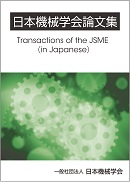Volume 89, Issue 926
Displaying 1-16 of 16 articles from this issue
- |<
- <
- 1
- >
- >|
TRANSLOG2022
-
2023Volume 89Issue 926 Pages 23-pre02
Published: 2023
Released on J-STAGE: October 25, 2023
Download PDF (873K) -
2023Volume 89Issue 926 Pages 23-00081
Published: 2023
Released on J-STAGE: October 25, 2023
Advance online publication: July 24, 2023Download PDF (3087K) -
2023Volume 89Issue 926 Pages 23-00112
Published: 2023
Released on J-STAGE: October 25, 2023
Advance online publication: October 23, 2023Download PDF (2552K) -
2023Volume 89Issue 926 Pages 23-00121
Published: 2023
Released on J-STAGE: October 25, 2023
Advance online publication: July 21, 2023Download PDF (6327K) -
2023Volume 89Issue 926 Pages 23-00134
Published: 2023
Released on J-STAGE: October 25, 2023
Advance online publication: July 24, 2023Download PDF (1958K) -
2023Volume 89Issue 926 Pages 23-00139
Published: 2023
Released on J-STAGE: October 25, 2023
Advance online publication: October 23, 2023Download PDF (2282K)
Solid Mechanics and Materials Engineering
-
2023Volume 89Issue 926 Pages 23-00168
Published: 2023
Released on J-STAGE: October 25, 2023
Advance online publication: September 27, 2023Download PDF (10476K) -
2023Volume 89Issue 926 Pages 23-00212
Published: 2023
Released on J-STAGE: October 25, 2023
Advance online publication: October 05, 2023Download PDF (2636K)
Thermal, Engine and Power Engineering
-
2023Volume 89Issue 926 Pages 23-00055
Published: 2023
Released on J-STAGE: October 25, 2023
Advance online publication: October 11, 2023Download PDF (3155K) -
2023Volume 89Issue 926 Pages 23-00172
Published: 2023
Released on J-STAGE: October 25, 2023
Advance online publication: October 05, 2023Download PDF (3700K)
Design, Machine Element & Tribology, Information & Intelligent Technology, Manufacturing, and Systems
-
2023Volume 89Issue 926 Pages 23-00006
Published: 2023
Released on J-STAGE: October 25, 2023
Advance online publication: September 27, 2023Download PDF (2556K) -
2023Volume 89Issue 926 Pages 23-00118
Published: 2023
Released on J-STAGE: October 25, 2023
Advance online publication: October 13, 2023Download PDF (2620K) -
2023Volume 89Issue 926 Pages 23-00138
Published: 2023
Released on J-STAGE: October 25, 2023
Advance online publication: October 13, 2023Download PDF (3947K) -
2023Volume 89Issue 926 Pages 23-00180
Published: 2023
Released on J-STAGE: October 25, 2023
Advance online publication: October 13, 2023Download PDF (2605K)
Transportation and Logistics
-
2023Volume 89Issue 926 Pages 23-00086
Published: 2023
Released on J-STAGE: October 25, 2023
Advance online publication: October 11, 2023Download PDF (6949K) -
2023Volume 89Issue 926 Pages 23-00101
Published: 2023
Released on J-STAGE: October 25, 2023
Advance online publication: October 11, 2023Download PDF (1913K)
- |<
- <
- 1
- >
- >|
